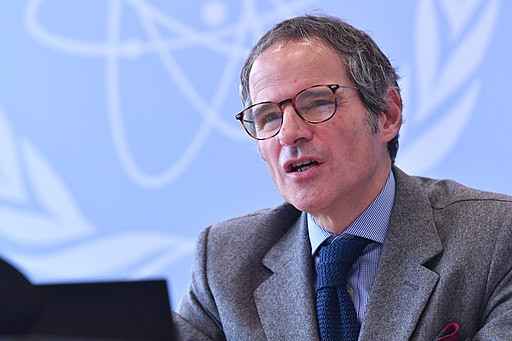IAEA Imagebank, CC BY 2.0 <https://creativecommons.org/licenses/by/2.0>, via Wikimedia Commons
U.S. National Security Advisor Jake Sullivan has attributed the Biden administration’s push for talks with Tehran to the need to “put Iran’s nuclear program in a box.” Iran has added urgency to the White House’s efforts by announcing ever greater nuclear advances in recent months.
But what if Iran is bluffing?
Tehran recently made largely unnoticed but remarkable claims about rapid progress to the brink of nuclear weapons capability, which we detailed in a recent report for the Jewish Institute for National Security of America. While these Iranian claims are certainly concerning, they are likely overstated for tactical effect. Tehran may be using the numbers in an attempt to raise the pressure on the Biden administration—and win sanctions relief in exchange for limiting its nuclear activities.
On Jan. 4, Iran resumed enriching uranium to 20 percent purity—not yet weapons-grade but far above the 3 to 5 percent needed for use in civilian power plants—after having agreed to stop enrichment and get rid of its entire stockpile in 2014. Five months after restarting enrichment, on June 15, Iran announced it had stockpiled 108 kilograms of the material. Though still short of the roughly 155 kilograms needed to produce enough weapons-grade uranium for one bomb, the June number was significantly more than the 63 kilograms reported by International Atomic Energy Agency (IAEA) inspectors just 24 days earlier on May 22.
Tehran’s claim, if accurate, implies a new breakneck campaign to cross the threshold of nuclear weapons capability as early as mid-July. This would be no trifling matter. Because 20 percent enrichment represents nine-tenths of the effort to achieve weapons-grade purity, the prospect of Iran accumulating 155 kilograms of uranium at this enrichment level was serious enough for then-Israeli Prime Minister Benjamin Netanyahu to define it as Israel’s red line at the United Nations General Assembly in 2012. Iran often came close to that red line but never dared to cross it. Until, it seems, now.
At first blush, this news might reaffirm U.S. and European officials’ desire to reenter the Joint Comprehensive Plan of Action quickly and roll back Iran’s worrisome stockpile, at least until 2031, when the deal would allow Iran to enrich however much uranium to whatever level it desired.
But Iran’s claimed stockpile is highly implausible. Between Jan. 4, when Iran resumed enrichment to 20 percent at its deeply underground Fordow facility, and May 22, it produced somewhere between 14 and 17 kilograms per month, depending on whether one believes Tehran’s data or the IAEA-verified numbers. These rates would put Iran on pace to cross Netanyahu’s red line by late September or early October, respectively. Both these enrichment rates are already significantly higher than the peak of 8 kilograms per month reached at Fordow prior to the 2014 agreement to stop enrichment.
For Tehran’s stockpile to have jumped to 108 kilograms between May 22 and June 15, however, would have required Tehran roughly to double or even triple its Fordow enrichment rate overnight, to either 37 or 54 kilograms per month, depending on whether one believes Iran’s or the IAEA’s numbers. This is well above what the site’s limited number of rudimentary centrifuges can handle. Other scenarios for making such a massive leap—suddenly installing a huge number of advanced centrifuges or using an undisclosed facility—are equally improbable.
Iran’s incredible claim is further undermined by its July 6 decision to produce enriched uranium metal from the enriched uranium gas produced by the Fordow centrifuges. On the one hand, this announcement is deeply troubling because Iran will be gaining mastery of yet another step on the path to a nuclear warhead. On the other hand, this move increases the time Iran still needs for making a bomb because making the metal does require drawing down its stockpile of 20 percent enriched uranium.
All this strongly suggests Iran is overstating its stockpile of 20 percent enriched uranium. It can do so because, since February, it has effectively kicked out international inspectors who could verify its nuclear program.
The question is why Tehran would want to exaggerate like this. One reason is that the Biden administration has proved particularly susceptible to pressure from Tehran’s ticking nuclear clock. A sudden increase in Iran’s stockpiles might inject new urgency into the plodding—and seemingly stalled—Vienna negotiations.
Tehran might also have been testing the intentions of the new leadership in Jerusalem. The stockpile announcement with its likely exaggeration came less than 48 hours after the official formation of the new Israeli government, a tenuous coalition whose approach to Iran’s nuclear ambitions—and how that approach would differ from Netanyahu’s—remains to be seen.
Ultimately, no matter whether Tehran has taken a massive nuclear leap or is boldly exaggerating its achievements, it underscores growing Iranian confidence that it can threaten to step right up to the nuclear red line without any real pushback from the United States. For U.S. President Joe Biden to fulfill his promise that Iran will “never get a nuclear weapon on my watch,” his administration must flip these dynamics on their head.
Neither Iran’s deceptions nor its sense of impunity can go unchallenged. U.S. diplomats need to publicly question inconsistent Iranian claims while pressing Tehran to adhere to its nonproliferation obligations and allow full access for international inspectors. Washington should explain that Tehran’s current ambiguity about its enrichment activities will ultimately prove dangerous: It raises uncertainty and reduces risk tolerance among those determined to stop Iran from acquiring nuclear weapons capability.
While resisting Iranian pressure to make concessions, the United States must also build more effective counterpressure. If, despite Iran’s deceptions, the White House feels compelled to continue negotiations toward what will necessarily be an even weaker deal than in 2015, it should set a firm and timely deadline and communicate the consequences of further Iranian intransigence.
In this, U.S. officials should note Netanyahu’s success: Tehran conspicuously avoided crossing his red line, fearing Israeli military action. Beyond publicly endorsing and supporting Israel’s freedom of action to continue defending itself, the Biden administration should make clear that the United States also has viable alternatives to diplomacy for preventing a nuclear Iran.
Washington cannot “put Iran’s nuclear program in a box” without first putting Tehran in a box. That means calling its bluff and refusing to give in to its nuclear brinkmanship.
Blaise Misztal is the vice president for policy at the Jewish Institute for National Security of America. Jonathan Ruhe is the director of foreign policy at the Jewish Institute for National Security of America.

